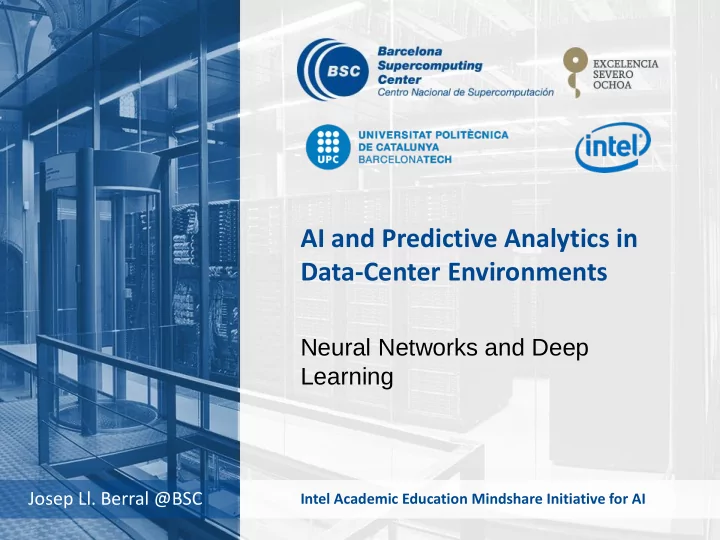

AI and Predictive Analytics in Data-Center Environments Neural Networks and Deep Learning Josep Ll. Berral @BSC Intel Academic Education Mindshare Initiative for AI
Introduction “Neural networks attempt to imitate the brain neuron mechanisms” “Actually, mathematical artifacts that learn non - linear models”
Introduction • Neural networks: allow non-linear models More Dimensions Dimensions
Introduction • NNs: Adjusts input weights after passing data repeatedly Data Neural Net Predict Adjust Get the error Repeat this until error is low enough
Introduction • NNs: Adjusts input weights after passing data repeatedly Data Neural Net Predict Adjust Get the error Repeat this until error is low enough Repeat this with different NN tuning until error is even lower
Introduction • NNs: Adjusts input weights after passing data repeatedly Predic Data Neural Net Lots of Experiments to RUN! t Adjust Get the error Repeat this until error is Parallelism is Welcome low enough Repeat this with different NN tuning until error is even lower Accelerators are Welcome Any optimization is Welcome
Introduction • Schema of Perceptron (basic linear neuron) • Example... g(x) = sigm(f(x)) Inputs x Output g(x) f(x) = ∑(x i · w i + b i ) y i = g(f(x)) = sigm (∑ (x i · w i + b i ))
Introduction • …but simple neurons can’t learn non -linear mechanisms • We can create networks! • Example of XOR (non-linear) • XOR is not linear, so requires neuron composing Input Output “ hidden layer ” Multi-Layer Perceptrons (MLP)
Training a regular NN • Iterative process on MLPs Predict → ŷ 2 X ŷ 1 Input Output ε = Y - ŷ 2 ε = Ỹ 1 - ŷ 1 ← Check error & Adjust Repeat until acceptable error/reach iteration limit
Composition of NNs • Decisions: • How many hidden layers? h1 Input Output h1 h2 Input Output h1 h2 h3 Input Output
Composition of NNs • Decisions: • How many neurons per layer? h1 Input Output h1 Input Output h1 Input Output
Composition of NNs • Decisions: • Which kind of neuron per layer? • Linear? Sigmoid? Rectifier? Convolutional? ... h1 h2 Input Output sigmoid convolutional linear + pooling
Composition of NNs • Decisions: • Do we have any kind of “recurrence”? (back connections?) h1 h2 Input Output
Composition of NNs • Decisions: • How many iterations? Any “stop” criteria...? Predict → h1 h2 Input Output How many “EPOCHS” ← Adjust (iterations)?! • Also other hyper-params! (learning rate, momentum...)
Composition of NNs • Most of these issues and decisions: EXPERIMENTS → TRIAL/ERROR Executions!
Details of Neural Networks • Readability • NNs are hard to “read” • Can’t know always what’s happening inside • Sometimes, weights can be visualized • See the weights of each neuron
Details of Neural Networks • Example: MNIST • Hand-written number recognition HL (30 neurons) Input (28x28) (10 neurons) Output 9
Deep Neural Networks • Some hard problems can be solved using “Deep” NNs • … Those are NNs with several hidden layers • Highly complex datasets require high degree of layers + neurons • Training require High Performance Computing • E.g. image recognition scenarios conv + pool + relu 10000 neurons conv + pool + 2000 neurons conv + pool + 50000 neurons Input (image) 1000 neurons line + relu + flatten line + relu (classes) Output + sigm relu relu “ cat ”
DNN & Transfer Learning • Some trained NNs can be downloaded and tuned/adapted I trained this Trained NN The Internet I have new Trained data NN Little Data Refined training NN
DNN & Transfer Learning • We can re-train NNs for fine-grain tuning, even parts of a NN • E.g.: VGG19 (image recognition NN) + tuning “style” layer (hl4) • Transfer Learning on images: Update style Forward + VGG19 layer reconstruction
Summary • Neural Networks: • Method for Non-linear modeling • Capabilities: • Multi-dimensional data • Transfer Learning • Difficulties: • NN smithering and tinkering • Decide architecture • Decide hyper-params • Checking each decision → AN EXPERIMENT TO RUN!
Recommend
More recommend